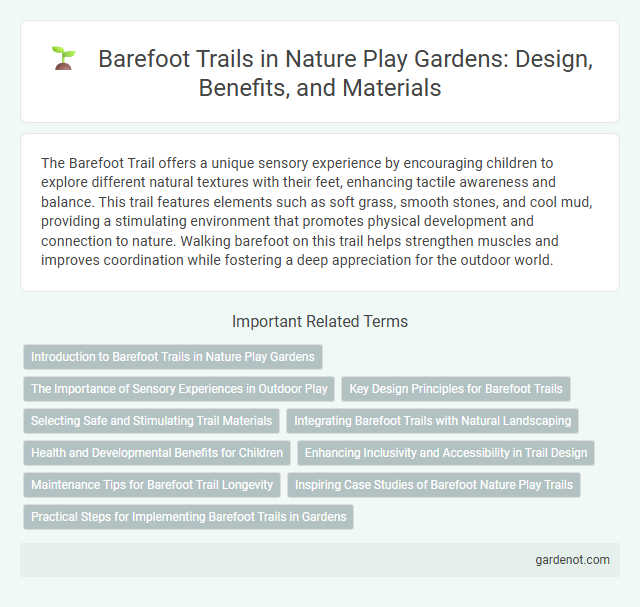The Barefoot Trail offers a unique sensory experience by encouraging children to explore different natural textures with their feet, enhancing tactile awareness and balance. This trail features elements such as soft grass, smooth stones, and cool mud, providing a stimulating environment that promotes physical development and connection to nature. Walking barefoot on this trail helps strengthen muscles and improves coordination while fostering a deep appreciation for the outdoor world.
Introduction to Barefoot Trails in Nature Play Gardens
Barefoot trails in nature play gardens offer a sensory-rich experience by encouraging direct contact with diverse natural materials like soil, pebbles, wood chips, and grass. These trails stimulate tactile exploration, enhancing children's sensory development, balance, and motor skills through varied textures and uneven surfaces. Integrating barefoot trails into play environments promotes mindfulness, grounding, and a deeper connection to nature.
The Importance of Sensory Experiences in Outdoor Play
Barefoot trails enhance sensory experiences by stimulating tactile feedback through varied natural surfaces like grass, sand, and wood. Engaging multiple senses during outdoor play fosters cognitive development, balance, and spatial awareness in children. These sensory-rich environments encourage curiosity and promote emotional well-being by connecting kids directly with nature.
Key Design Principles for Barefoot Trails
Key design principles for barefoot trails emphasize varied textures and natural materials such as sand, pebbles, wood chips, and mud to stimulate sensory exploration and enhance tactile experiences. Incorporating diverse terrain gradients and climate-appropriate elements supports foot strength, balance, and proprioception while ensuring safety and accessibility for all ages. Strategic placement of benches and shade improves comfort, encouraging longer engagement with nature play environments.
Selecting Safe and Stimulating Trail Materials
Choosing safe and stimulating materials for a barefoot trail involves prioritizing natural elements like smooth river stones, soft wood chips, and sand that enhance tactile sensory experiences while minimizing injury risks. Materials must be non-toxic, free of sharp objects, and provide varied textures to promote sensory development and encourage adventurous exploration. Regular maintenance ensures the trail remains clean and safe, supporting continuous engagement and physical benefits for children.
Integrating Barefoot Trails with Natural Landscaping
Integrating barefoot trails with natural landscaping enhances sensory experiences by utilizing organic materials such as wood chips, river stones, and soft moss, which stimulate foot reflexology and promote mindfulness. Native plants along the path create shade and improve air quality, while naturally contoured terrain encourages physical activity and balance development. This eco-friendly approach supports local biodiversity, reduces maintenance, and fosters a deeper connection to the environment through immersive nature play.
Health and Developmental Benefits for Children
Barefoot trails enhance children's sensory development by stimulating nerve endings in the feet, promoting balance and coordination. Walking barefoot on varied natural surfaces strengthens muscles and improves proprioception, essential for overall motor skills. Exposure to natural textures also boosts immune function by encouraging adaptive responses to environmental microbes.
Enhancing Inclusivity and Accessibility in Trail Design
The Barefoot trail incorporates soft, natural textures like sand, mud, and grass, promoting sensory engagement for diverse users, including those with mobility challenges. Thoughtful design elements such as gradual slopes, wide paths, and tactile markers enhance accessibility while preserving an immersive nature experience. This approach fosters inclusivity by enabling people of varying ages and abilities to explore and connect with the environment barefoot safely.
Maintenance Tips for Barefoot Trail Longevity
Regularly inspect the barefoot trail for debris, sharp objects, and erosion to ensure safety and comfort for users. Use natural materials like wood chips, sand, and smooth river stones that are replenished periodically to maintain cushioning and texture. Proper drainage management prevents water accumulation, preserving trail integrity and extending its lifespan.
Inspiring Case Studies of Barefoot Nature Play Trails
Barefoot nature play trails, such as the Treetop Adventure Trail in New Zealand and the Forest Feet Path in Germany, demonstrate significant benefits in sensory development, balance, and motor skills for children. These inspiring case studies highlight how natural materials like wood chips, pebbles, and sand create diverse tactile experiences that enhance engagement and mindfulness. Educational programs integrated with barefoot trails consistently report improved physical coordination and increased environmental awareness among participants.
Practical Steps for Implementing Barefoot Trails in Gardens
Creating a barefoot trail in gardens involves selecting diverse natural materials such as mud, sand, pebbles, and grass to stimulate sensory experiences and foot muscle development. Integrating varied textures and slight elevation changes enhances balance and proprioception, supporting overall physical health through tactile engagement. Regular maintenance to ensure cleanliness and safety, alongside educational signage, encourages mindful interaction and maximizes benefits for users of all ages.
Barefoot trail Infographic

 gardenot.com
gardenot.com